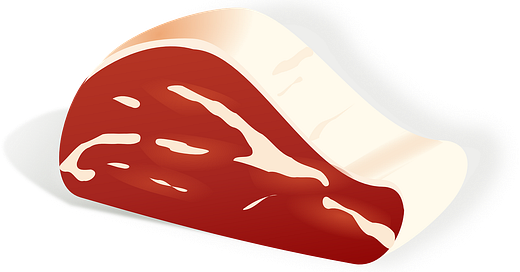My Most Recent Podcast
My most recent guest on Brave New World was Uma Valeti, founder and CEO of Upside Foods. Uma is a former cardiac surgeon who gave up a stable and lucrative career to pursue something bigger and more impactful: growing cultivated meat from animal cells.
Cultivated meat? It sounds like something out of Star Trek. I never imagined seeing this in my lifetime.
We recorded the conversation at Uma’s office at Upside Foods. There’s a Zen-like vibe at Upside, which reflects his low-key style and a single-minded pursuit of his vision: to change the future of meat by making it healthier, more humane, and more sustainable than the status quo. As one of his employees chuckled, “now you can have your meat and eat it too.”
Interestingly, Uma and I stopped eating meat for the same reason. He recalled an incident in his childhood at a friend’s birthday party, with animal slaughter happening behind the house while kids raced around gleefully. The event brought him face to face with an uncomfortable truth about animal cruelty that most of us ignore. My own decision was based on the mass animal suffering described by Peter Singer in his book, Animal Liberation. I’m was unable to turn a blind eye to the meat industry after reading Peter’s book.
Uma now eats his own meat! And I’m looking forward to making my signature Kashmiri dish called “Rogan Josh” with Upside’s cultivated meat. We mused whether Hindus would eat cultivated beef, and whether Muslims would eat cultivated pork. What a bizarre world that would be.
Uma and I had an awesome conversation, so you’ve got to listen to the episode:
https://bravenewpodcast.com/episodes/2025/03/13/episode-93-uma-valeti-on-cultivating-meat/
The Future of Meat
I’ve been following the “alt meat” industry for some time, but feel like I saw the future of meat much more clearly during my conversation with Uma. What had seemed like science fiction until now is science. While there are serious challenges to be overcome to create meat at scale, the science has been proven to work, which is the most critical hurdle.
I took a deep dive into the industry a few years ago in preparation for my podcast conversation with Paul Shapiro, who is the author of the book Clean Meat and founder of the Better Meat Co. I’ve had two subsequent conversations about the innards of the meat industry with moral philosopher Peter Singer and animal rights activity Maneka Gandhi (winner of the Peter Singer award on her work on animal welfare), which don’t paint a pretty picture of the meat industry.
Shapiro’s book describes the various approaches being pursued to produce an alternative to industrial slaughterhouse meat. There’s been a lot of effort on alternatives, mostly using plant-based substrates, but they are expensive and have not replicated the experience of eating real meat.
Interestingly, Uma’s inspiration came from his background as a cardiac surgeon. He said he was fascinated by how heart muscle would regenerate after stem cells were injected into the heart. However, the challenge there is that the regenerated cells must function properly for the lifetime of the patient, which is a tall order. But it made him ask why the generation of cells couldn’t occur outside the body. If so, the cells only need to survive until the meat is ready to harvest. It’s a much easier problem to solve.
What I realized during my conversation with Uma is that the most fundamental requirement, namely, the proof of science, has been addressed. If cultivated meat feels and smells like animal meat, its consumption will depend on its safety and affordability.
The proof of safety has also been demonstrated, The FDA approved Upside’s meat a couple of years ago. Indeed, it is arguably safer than conventional meat, which causes almost fifty million cases of food poisoning every year in the US.
A Disruption?
A classic framework used in business schools to understand why established industries get disrupted is Clay Christensen’s “Innovator’s Dilemma.” The framework shows how dominant players in an industry get upstaged by ignoring an inferior product or technology that has other advantages, but customers don’t want it, especially if it’s more expensive.
Meat is in that stage. The industrial meat complex is highly efficient and subsidized, and none of the meat substitutes have matched up to the real thing until now. An “impossible burger” is nice, but it isn’t as good as an old-fashioned burger. And a steak made with plants doesn’t match a real steak.
But what if people couldn’t tell the difference between industrial meat and cultivated meat? Would industrial meat eventually become obsolete?
Consider the major forces at play.
The environmental impact from getting rid of half the industrial meat would be massive, on par in some ways with reducing fossil consumption by half. The livestock industry is responsible for 40% of methane emissions, 30% of freshwater use, and 80% of farmland and deforestation. The elimination of industrial meat would mitigate climate change, restore natural ecosystems, and improve the environment and human health. The impacts of industrial meat on the environment are major “externalities” imposed by the industry on society that don’t show in the price of meat at the supermarket.
Cultivated meat is also likely to be safer than industrial meat, which is full all kinds of bacteria and begins to spoil quickly. And not having to deal with Salmonella, E.coli and other potential contaminants from the slaughterhouse reduces the risks associated with meat going bad.
The critical factor will be price. At the moment, a chicken enchilada costs almost twenty dollars, which is rich. If cultivated meat reaches a reasonable price point, such as that of organic meat, I can see a massive disruption of the meat industry shaping up. In which case, perhaps Uma’s vision of sparing animals from mass cruelty and sparing humans from the perils of industrial meat (that causes them to show up on his former operating room table) will become reality. Quoting him from Shapiro’s book:
“In this day and age do we still need to grow a whole organism to break it down into little pieces for the simple tissue that we like to eat? Or can we fundamentally change this paradigm and grow this tissue from the building blocks of life: cells? Our goal is to produce a world where we can harvest animal products without harming life.”
I’m betting on it.





